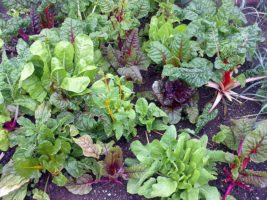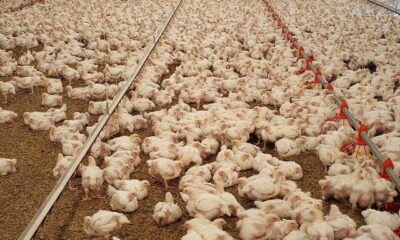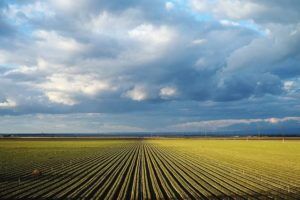

Environment
How to Start Your Organic Garden
Organic vegetables are healthy and have a wonderful taste. If you would like to grow your own, here are some tips that can help.
Don’t compare your first organic gardening efforts to those of your neighbour’s, or the ones you see in book, TV shows or magazines. Do the best you can do in the space you have. Start with a few types of vegetables and don’t overwhelm yourself.
How to Start Your Organic Garden
Pros advise new gardeners to start by picking the size of the garden space. The ideal size for a beginner is 10-by-16 feet. If your space is smaller you can create shorter rows and use fewer plants. The plots should run from north to south for ideal sun exposure.
After choosing the size and location for your garden, look for easy-to-grow organic vegetables. Growing Plants 101: The Complete Guide to Getting Started, suggests growing vegetables that you eat such as potatoes, cucumbers, peas, peppers and tomatoes. If you find that you don’t have space for these vegetables in your garden area, consider container gardens which are ideal for smaller spaces. Just make sure the plants you place in the container require a similar pH level.
You can use companion planting in your garden and work with nature instead of against it. Some plants have a symbiotic relationship that can help each plant survive. This is the type of relationship that carrots and tomatoes have, which can lead to higher yields and heartier plants when grown together.
Vegetables require ammonia, which is a combination of nitrogen and hydrogen. By planting legumes, such as peas and beans, near nitrogen loving plants such as kale and broccoli, you should see an improvement in growth.
Clothing and Tools
There are a few basic tools the beginning gardener needs. These include a trowel, steel rake, shovel, and watering can or hose. If you plan on planting tomatoes you may need cages. If you’re going to do a container gardening you need pots. You can use the shovel to move or till the soil and cut through weeds. The trowel is used to manage small amounts of soil, tackle small seeds and transplant seedlings. The rake is used to compact and grade soil.
When gardening, wear clothes that you don’t mind getting dirty or muddy. You should use sunblock to protect your skin and insect repellent to avoid bug bites. Gloves will protect your hand and nails. You can keep your gardening clothes and shoes in the garage or storage area, in order to save time when going out to your garden.
Preparing the Plot
According to Wellness Mama, sunshine and water are the most important element necessary for a successful organic garden. Your plot should get at least six to eight hours of daily sunlight in the summer. The organic soil should be high quality and include compost. The soil is extremely important if you are building a raised bed garden or using containers. To have a supply of high-quality soil on hand for future gardening projects, start a compost bin in your yard. Until the compost in your bin is ready, you can purchase compost to mix with your soil at your local garden center.
You should start preparing your plot in early spring. Make sure there are no tree roots encroaching in your plot, remove all grass and create a garden border. If you have pets or if there is local wildlife in the area, a small fence surrounding the garden should be useful.
Dig the soil to loosen clumps. Go at least a foot deep into the soil, to allow air to enter, using a shovel or rototiller? Then, rake to smooth the soil’s surface.
Draw a diagram showing where you want to place your vegetables. Purchase organic seeds, organic seedlings, and the other gardening supplies and get ready to plant.
Planting and Maintenance
For each plant, dig a depression and add water until the soil is moist to a depth of 1 inch. If the soil on top appears dry, water again. Add old newspapers or pine needles around the plant to help with water retention. If you’re planting during the high-temperature days, water daily.
Organic fertilizers are available in several types including microbial growth promoters. These fertilizers are made from organic ingredients such as bat guano or fish meal. The packages show the amount of nitrogen, potash and phosphorous in each item. Consult with an associate at your local garden centre to choose the right fertilizer for your local climate and soil conditions.
Weeds are a fact of life for organic gardeners. Pulling weeds can be effective, however, you must check the garden regularly so that it does not become overgrown.
Pests are the biggest problem for organic gardeners. Plants are often able to fight off pests without assistance, especially if you’re using companion planting techniques. However, if you need additional help eliminating pests use organic bug killers.
Now that you have this information, you can get started on your new organic garden.


 Environment9 months ago
Environment9 months agoAre Polymer Banknotes: an Eco-Friendly Trend or a Groundswell?

 Environment11 months ago
Environment11 months agoEco-Friendly Home Improvements: Top 7 Upgrades for 2025

 Features8 months ago
Features8 months agoEco-Friendly Cryptocurrencies: Sustainable Investment Choices

 Features9 months ago
Features9 months agoEco-Friendly Crypto Traders Must Find the Right Exchange





























